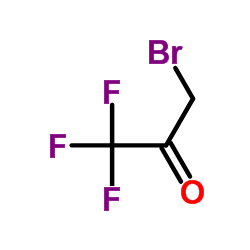1-Bromo-3,3,3-trifluoroacetone

1-Bromo-3,3,3-trifluoroacetone structure
|
Common Name | 1-Bromo-3,3,3-trifluoroacetone | ||
|---|---|---|---|---|
| CAS Number | 431-35-6 | Molecular Weight | 190.947 | |
| Density | 1.8±0.1 g/cm3 | Boiling Point | 87.7±0.0 °C at 760 mmHg | |
| Molecular Formula | C3H2BrF3O | Melting Point | <-80ºC | |
| MSDS | Chinese USA | Flash Point | 5.0±0.0 °C | |
| Symbol |


GHS02, GHS05 |
Signal Word | Danger | |
|
Conformational change study of dengue virus NS2B-NS3 protease using (19)F NMR spectroscopy.
Biochem. Biophys. Res. Commun. 461 , 677-80, (2015) The dengue virus NS2B-NS3 protease (NS2B-NS3p), an important antiviral target for drug development, has been reported to adopt an open or closed conformation in crystal structures with different NS2B C-terminus (NS2Bc) positioning. In solution, nevertheless, ... |
|
|
Actin dynamics studied by solid-state NMR spectroscopy.
Eur. Biophys. J. 19(3) , 147-55, (1991) Solid-state nuclear magnetic resonance spectroscopy was used to study the motion of 2H and 19F probes attached to the skeletal muscle actin residues Cys-10, Lys-61 and Cys-374. The probe resonances were observed in dried and hydrated G-actin, F-actin and F-ac... |
|
|
Substituted trifluoroketones as potent, selective inhibitors of mammalian carboxylesterases.
Biochem. Pharmacol. 36(12) , 1869-79, (1987) A series of substituted trifluoroketones were tested as inhibitors of mammalian liver microsomal carboxylesterase(s) hydrolyzing a variety of substrates including malathion, diethylsuccinate (DES) and p-nitrophenyl acetate (p-NpAc). The trifluoroketones used ... |
|
|
Novel histone deacetylase inhibitors: cyclic tetrapeptide with trifluoromethyl and pentafluoroethyl ketones.
Bioorg. Med. Chem. Lett. 14(21) , 5343-6, (2004) Cyclic tetrapeptides containing trifluoromethyl and pentafluoroethyl ketone as zinc binding functional group were synthesized as potent HDAC inhibitors. Evaluation by human HDAC inhibition assay and p21 promoter assay showed that these inhibitors are promisin... |
|
|
19F nuclear magnetic resonance studies of selectively fluorinated derivatives of G- and F-actin.
Biochemistry 25(8) , 2187-91, (1986) G-Actin is a globular protein (Mr 42 300) known to have three cysteine residues that are at least partially exposed and chemically reactive (Cys-10, -284, and -374). When G-actin was reacted with 3-bromo-1,1,1-trifluoropropanone, three resolvable 19F resonanc... |
|
|
Interaction between G-actin and various types of liposomes: A 19F, 31P, and 2H nuclear magnetic resonance study.
Biochemistry 37(9) , 3149-55, (1998) We have investigated in the present study the interaction between G-actin and various types of liposomes, zwitterionic, positively charged, and negatively charged. To investigate at the molecular level the conformation of actin in the presence of lipids, we h... |
|
|
Effect of magnetic susceptibility on nuclear magnetic resonance signals arising from red cells: a warning.
Biochemistry 22(17) , 4119-25, (1983)
|
|
|
A combined nuclear magnetic resonance and absorbance stopped-flow apparatus for biochemical studies.
Anal. Biochem. 189(2) , 267-73, (1990) A combined NMR and absorbance stopped-flow has been developed for monitoring the kinetics of biochemical reactions. We demonstrate its usefulness in following the alkaline denaturation of human hemoglobin. No glassblowing is required in the fabrication of the... |
|
|
Novel reductive olefination mediated by Ti (Oi-Pr) 4 and Ph3P. One-pot synthesis of trifluoromethylated trans-allylic alcohols. Shen Y, et al.
Chem. Commun. (Camb.) 20 , 2195-2196, (1998)
|
|
|
Reaction of ethyl 4, 4, 4-trifluoroacetoacetate enolate with 3-bromo-1, 1, 1-trifluoroacetone: synthesis of 2, 4-bis (trifluoromethyl) furan. Smith JO, et al.
J. Fluor. Chem. 81(2) , 123-8, (1997)
|